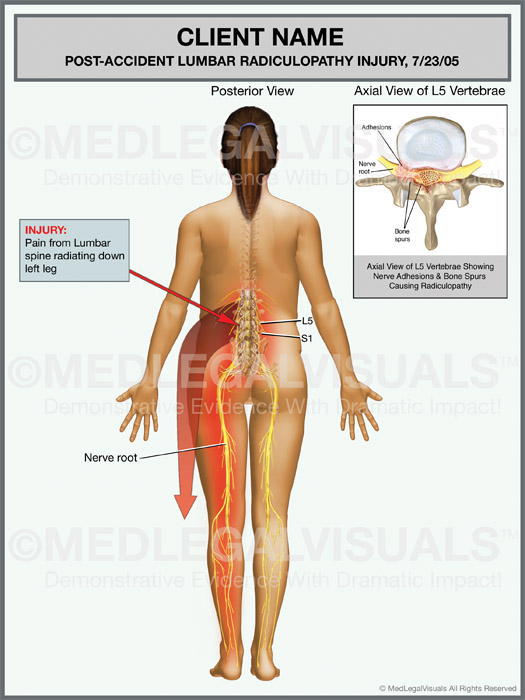Many injuries can result from an auto accident. Your spine, one of the most complex parts of your body, is also one of the vulnerable in the event of a collision. The effects of a spinal injury can be long-lasting and very painful. Among these injuries, a lumbar radiculopathy can be among the most aggravating in your day to day life. Making sure you know exactly what part of your body was injured is crucial to getting proper medical care. Experienced personal injury attorneys understand the kinds of injuries that result from serious car accidents and can help you find the right track for your recovery from your injuries.
Your First Step After a Car Accident
Download Our Free Car Accident Guide!
At Premier Law Group, we believe in educating people who have been injured in car accidents so they can make good decisions regarding their situations. That’s why one of our partners, Jason Epstein, wrote a guide called The Truth About Washington Auto Accidents and we give it away for free. In this guide you’ll discover:
- Ten insider secrets that insurance companies hide from you.
- The “service” some lawyers provide that is actually a “kiss of death” to your car accident claim.
- Whether or not your health insurance company can force you to repay them if you win your claim.
- The one document you should never sign for an insurance company.
Discover Other Useful Information
The Premier Law Group website contains a wealth of information and resources for people injured in Washington State car accidents. Click the links below to discover…
- Our Vehicle Claim Calculator to see how much your claim is worth
- Frequently asked questions about car accidents in Seattle
- Helpful car accident articles
- Definitions for legal terms
What is Lumbar Radiculopathy?
Radiculopathy is when a compressed nerve in the spine causes pain, numbness, tingling, or weakness along the course of the nerve. Radiculopathy can occur in any part of the spine, but it is most common in the lower back, which is called lumbar radiculopathy. Nerve roots branch out from the spinal cord and carry messages to and from the brain, the lower extremities, and pelvis. If one of these roots is injured in the area where it leaves the spine, it is called a radiculopathy. In a car or motorcycle accident, compression injuries to the spine can cause lumbar radiculopathy.
The symptoms of radiculopathy depend on which nerves are affected. The nerves from the lower back (lumbar spine) control the muscles of the buttocks and legs and supply sensation there. The most common symptoms of radiculopathy are pain, numbness and tingling in the arms or legs. It is also common for patients to have localized neck or back pain. When lumbar radiculopathy causes pain that radiates down a lower extremity, it is commonly referred to as sciatica. Some patients develop a painful hypersensitivity to light touch. Less commonly, patients can develop weakness in the muscles controlled by the affected nerves, indicating nerve damage.
In this interactive video from Spine-Health’s website, see how the body is affected by injury to the spine: http://www.spine-health.com/video/sciatica-interactive-video

Image courtesy MedLegalVisuals
How Will Your Doctor Diagnose Lumbar Radiculopathy?
Your doctor will always perform an initial physical examination, but will not diagnose you until they have thoroughly tested you. After the initial examination, the diagnosis of lumbar radiculopathy can be supported in many different ways including different imaging machines to see your spine. Treatment of lumbar radiculopathy will vary depending on the actual cause of the radiculopathy. These treatments can include the use of back supports, medication, physical therapy, steroid injection in the spine, and even surgery.
Your doctor will most likely follow this series of steps until they are comfortable giving you a diagnosis:
Ask about your medical history. They will likely ask about the type, location and duration of symptoms, presence of weakness, any current therapy, questions regarding your family medical history, and if your symptoms have caused you to miss any work.
Perform a physical examination. Your caregiver may test you for weakness, numbness, or tingling in your back, buttocks, and legs through a series of exercises and reflex exams.
Blood Tests. You may need blood taken to give your doctor information on how your body is working.
Give you an X-ray. X-rays are far less expensive than any additional testing you may receive. However, they can not produce an image for much other than broken bones, or very severe spinal deficiencies.
Give you a Magnetic Resonance Imaging (MRI) test. An MRI machine is also used to take a picture of your lower back. This picture will be used to check for problems and changes in your backbones, nerves, and discs.
Electromyography (EMG). An EMG tests the function of your muscles and the nerves that control them. The testing is done while your muscles are resting, and during activity.
Computed Tomography (CT) scan. A special x-ray machine uses a computer to take pictures of your lower back. It may be used to look at your bones, discs, and nerves. You may be administered a radioactive dye in your IV to help improve the pictures.
How is Lumbar Radiculopathy Treated?
Treatment of lumbar radiculopathy may reduce pain and swelling, improve your ability to walk, and allow you to do your normal activities. As a personal injury attorney, I know that diagnosis and seeking treatment options can take a lot of time and money. This is why you should make sure that you have a qualified doctor and an experienced injury attorney on your side. Here are some potential treatment options your doctor will talk to you about:
- Medicines:
- Nonsteroidal anti-inflammatory (NSAID) medicine may decrease swelling and pain or fever. This medicine can be bought with or without a doctor’s order, but should only be purchased as the result of a doctor’s recommendation.
- Muscle relaxers may be used to decrease pain and muscle spasms.
- Opioids are a strong medicine given to reduce severe pain, but will only be prescribed for extreme cases.
- Oral steroids can be used to reduce swelling and pain.
- Steroid injections may be given through a needle into your lumbar spine. This may help decrease your nerve pain and swelling, however, you may need more than one to show signs of improvement.
- Physical therapy: Your physical therapist may teach you certain exercises to improve posture, flexibility, and strength in your lower back. They may also teach you how to remain safely active and avoid further injury.
- Transcutaneous electrical nerve stimulation: This treatment, called TENS, stimulates your nerves and may decrease your pain. Wires are attached to pads and then attached to your skin, then the wires send a mild current through your nerves.
- Surgery: You may need surgery to relieve a pinched nerve if your condition has not improved within 4 to 6 weeks.
Lumbar radiculopathy is a serious injury and should be treated immediately. If you have been injured at the fault of someone else, do not hesitate to contact me right away in order to ensure you get the care that you deserve. Call us now at 206-285-1743.
Further reading:
